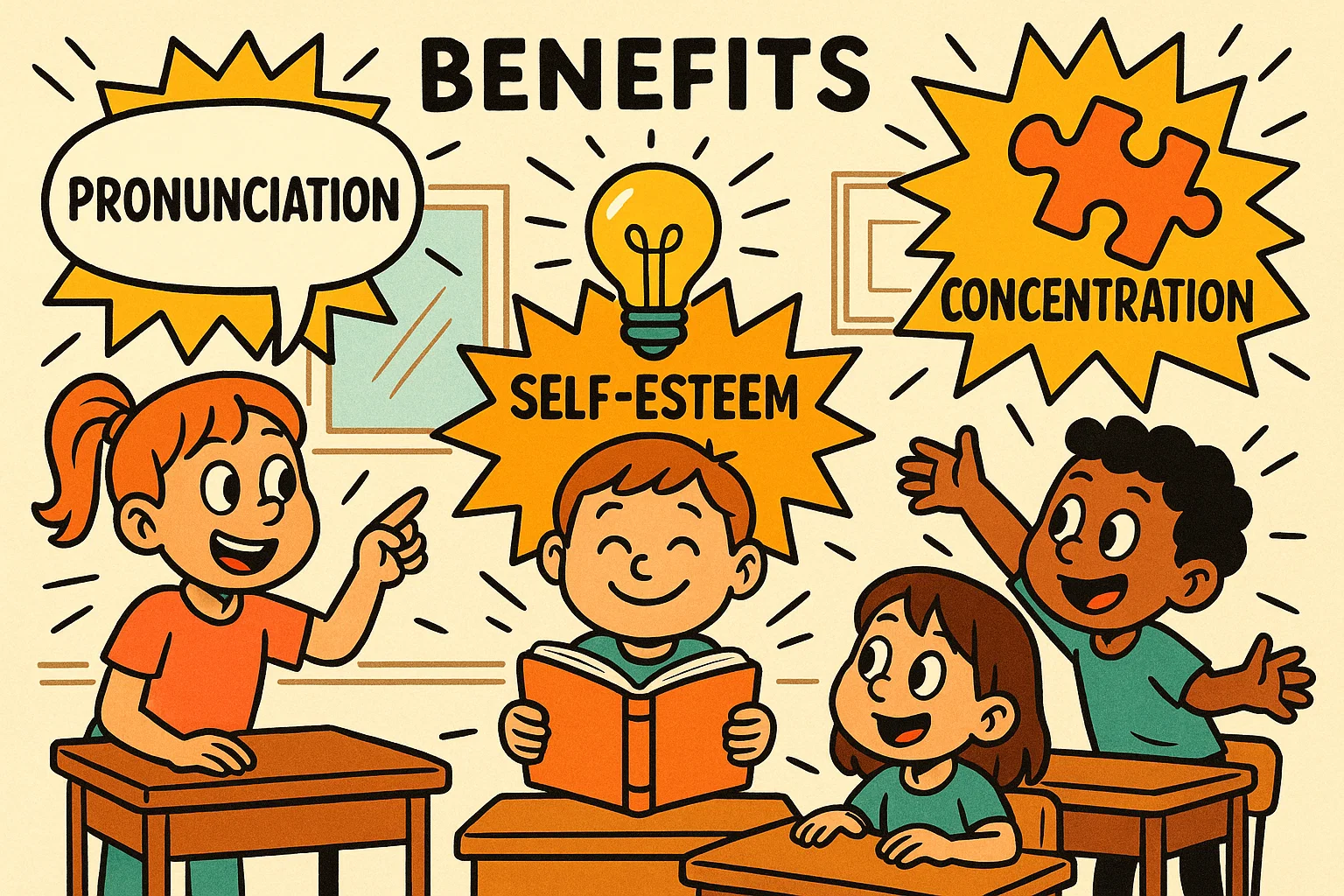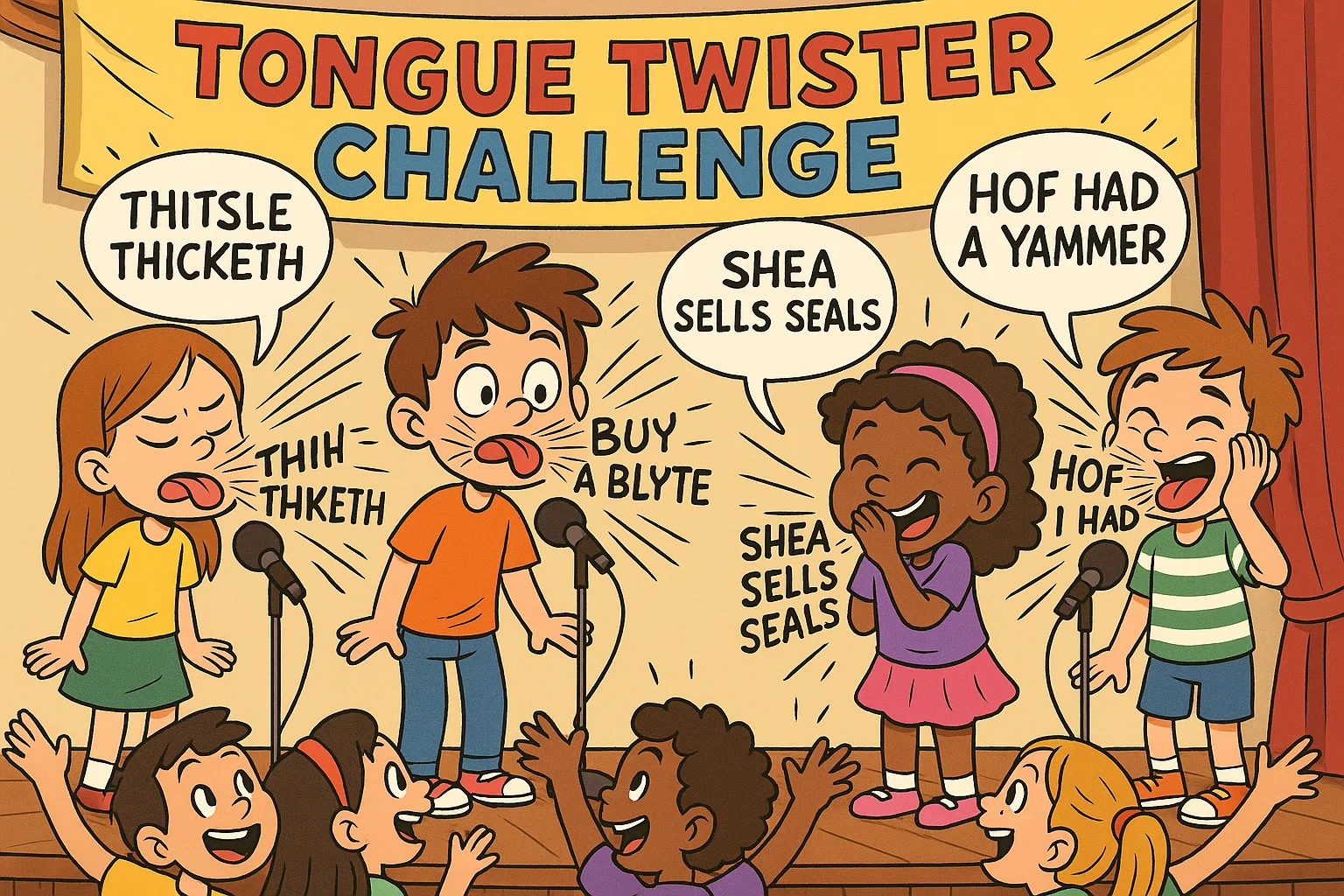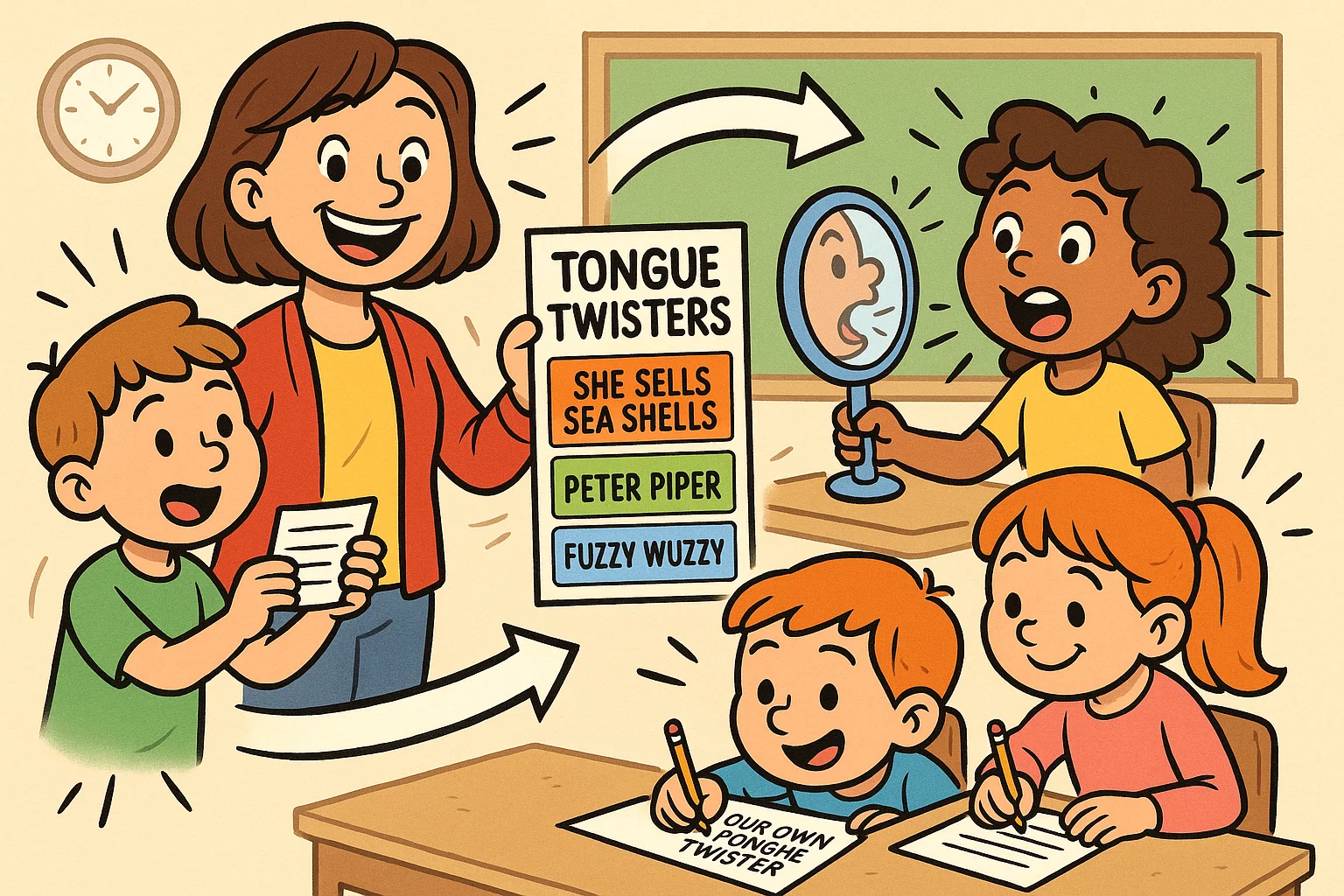Tongue Twisters for Kids: Fun Practice for Language and Speech Skills

Tongue twisters are playful “verbal gymnastics” that make speech practice fun. From classics like Peter Piper to short, silly lines, they boost articulation, vocabulary, memory, and confidence while keeping kids laughing. Easy to use at home or in class, they turn language learning into a game that builds lasting fluency.
Benefits of Tongue Twisters for Kids

Tongue twisters are far more than just silly rhymes; they are a subtle yet effective workout for a child’s brain and mouth. They help kids develop critical language and communication abilities that will serve them well throughout their academic and social lives.
Speech Development and Pronunciation
The core benefit of using tongue twisters is the focused practice they provide for challenging sounds and sound sequences. By repeatedly saying phrases like “a big black bug bit a big black dog,” a child’s mouth muscles get the practice needed to master articulation. This focused practice can significantly improve a child’s pronunciation and clarity of speech.
- Improved Articulation: They force the precise coordination of the lips, tongue, and jaw.
- Sound Discrimination: Kids learn to distinguish between subtle phonetic differences (e.g., ‘S’ vs. ‘Sh’ in “She sells seashells”).
- Enhanced Fluency: Practicing complex sequences at speed improves the flow and rhythm of the spoken word, boosting fluency.
Language and Vocabulary Growth
Many tongue twisters use less common words or specific literary devices like alliteration, which can broaden a child’s lexical base. For example, in the famous “Betty Botter bought some butter” twister, words like ‘bitter’ and ‘batter’ expand their vocabulary in a memorable context.
- Contextual Learning: New words are learned within a catchy, easy-to-recall phrase.
- Understanding Alliteration: Children naturally absorb the concept of repeating initial sounds, a key poetic device.
- ESL Support: For children learning English (ESL), tongue twisters in English are an excellent tool to practice specific, difficult sounds unique to the language, aiding in faster and more accurate English pronunciation.
Brain Training and Memory
The challenge of memorizing and accurately repeating a tricky phrase strengthens cognitive function. To say a tongue twister correctly and quickly, the brain must organize sounds and words in the right order, which enhances working memory and concentration.
- Concentration: Focus is required to prevent “tripping” over words.
- Sequencing Skills: Repeating the patterns helps the brain process sequential information.
- Auditory Memory: Children must remember the complex sequence of sounds they hear.
Confidence and Communication
Successfully mastering a hard tongue twister is a huge confidence booster. When a child can articulate a challenging phrase clearly, they feel more assured in their general speaking abilities. This confidence translates into greater willingness to participate in classroom discussions, give presentations, and engage in social conversations.
Fun Bonding Activity
Tongue twisters are excellent for family playtime or as a lively classroom speaking activity. They are often funny when spoken incorrectly, creating an atmosphere of shared laughter and learning. They require no equipment and are a fantastic way to give your tongue a workout while bonding over a fun challenge.
| Skill Developed | Example Tongue Twister | Primary Benefit |
| Articulation (P sound) | Peter Piper picked a peck of pickled peppers. | Muscle coordination for clear pronunciation. |
| Fluency & Rhythm (B sound) | Betty Botter bought some better butter. | Smooth transition between similar sounds. |
| Auditory Memory | I wish the wish you wish to wish. | Brain focus and sequential recall. |
Easy Tongue Twisters for Kids
Starting with simple, short tongue twisters is key to avoiding frustration. These are perfect for preschoolers and young elementary students just introducing tongue twisters.
Short Tongue Twisters
These typically have 3-6 words and focus on one clear sound.
- Red lorry, yellow lorry.
- A big black bug.
- Sheep sleep in a shed.
- Fuzzy Wuzzy was a bear.
Funny Tongue Twisters
The sillier they are, the more kids want to practice them!
- Six slippery snails slid slowly seaward.
- Flash message!
- A fly flew by.
- I scream, you scream, we all scream for ice cream.
Animal Themed Tongue Twisters
Animals are always a hit with young children.
- The cat caught the kitten.
- Cute kittens constantly cuddling.
- How much wood would a woodchuck chuck if a woodchuck could chuck wood? (A longer but famous one!)
- Two toads totally tired.
Food Themed Tongue Twisters
Relatable phrases about food make the practice sweeter.
- Cooks cook cupcakes quickly.
- Green glass globes glow greenly.
- Fresh fried fish, fish fresh fried.
- Give your batter better butter to make it better.
Intermediate Tongue Twisters for Kids

Once the basics are solid, move on to slightly longer and more complex phrases that demand more focus and breath control.
Rhyming Tongue Twisters
Rhyme adds rhythm, which helps with fluency and memorization.
- The sixth sick sheik’s sheep is sick.
- Swan swam over the sea, swim, swan, swim! Swan swam back again, well swum, swan!
- Wish the wish you wish to wish, but if you wish the wish the witch wishes, you won’t wish the wish you wish to wish.
Longer Tongue Twisters
These multi-line versions encourage improved breath control and sustained concentration.
- The great Greek grape growers grew great Greek grapes.
- Betty Botter bought some butter, but, she said, the butter’s bitter. If I put it in my batter, it will make my batter bitter. So she bought a bit of better butter, to make her bitter batter better. (This classic is great for practicing the ‘B’ sound).
Phonetic Focus Tongue Twisters
Targeting specific sounds that are commonly mixed up in English pronunciation.
| Sound Focus | Example Phrase | Challenge |
| S/Sh | She sells sea shells by the sea shore. | Differentiating between the two sounds. |
| R/L | Really rural, rarely lure all. | The difficult ‘R’ sound, especially for ESL learners. |
| Th | Thirty-three thousand thirsty thriving throats. | The challenging ‘voiced’ and ‘unvoiced’ ‘Th’. |
Group Activity Tongue Twisters
These are excellent for the classroom, creating a fun challenge for a whole group. Try having the kids say it in a round.
- Unique New York.
- A cross cow walked across a crowded cow crossing.
- I have a tricky tongue.
Challenging Tongue Twisters for Kids
For older children or highly confident young speakers, these hard tongue twisters provide a stimulating linguistic challenge.
Famous Tongue Twisters 🏆
These classics are famous for a reason—they are notoriously difficult to say quickly!
- Peter Piper picked a peck of pickled peppers. A peck of pickled peppers Peter Piper picked. If Peter Piper picked a peck of pickled peppers, where’s the peck of pickled peppers Peter Piper picked?
- How much wood would a woodchuck chuck if a woodchuck could chuck wood? The answer is: a woodchuck would chuck chuck as much wood as a woodchuck could!
Hard Tongue Twisters in English
These phrases are often cited in linguistic challenges for their complex sequencing.
- Thistle sifter, thrice-sifted thistle sifter. (Focuses on S and Th sounds).
- The tutor who tooted the flute tried to tutor two toothers. Said the two to the tutor, “Is it harder to toot or to tutor two tooters to toot?”
Long Funny Tongue Twisters
Combining length with humor makes the difficulty more enjoyable.
- A skunk sat on a stump and thunk the stump stunk, but the stump thunk the skunk stunk.
- Tutor two tooters to toot will surely give your tongue a workout!
Record-Breaking Tongue Twisters
What’s the hardest tongue twister ever? Linguists often debate this, but one of the hardest ones to say multiple times quickly is often cited as: “The sixth sick sheik’s sheep’s sick.”
How to Use Tongue Twisters With Kids

Effective practice is structured yet fun. Parents and teachers should approach this as a progression, tailoring the difficulty to the child’s skill level.
Warm-up Activities
Before diving into the phrases, start with simple vocal exercises.
- Breathing: Have the child take a deep belly breath before starting.
- Clear Speaking: Ask them to say a simple phrase like “Hello, how are you?” clearly and slowly.
- Stretch: Wiggle the tongue and stretch the mouth muscles gently.
Progress Gradually
Start with easy tongue twisters and gradually progress to more challenging ones. The goal is success, not frustration.
| Step | Technique | Goal |
| 1: Slow & Clear | Say the phrase very slowly, focusing on every sound. | Accuracy and sound recognition. |
| 2: Medium Pace | Repeat the phrase a few times, slightly speeding up. | Building muscle memory and rhythm. |
| 3: Fast & Fun | Try to say it as fast as possible for the fun challenge! | Achieving fluency and speed. |
Listening and Repeating Games
This is especially good for younger children. The adult says the twister, and the child repeats it. Use a playful, dramatic voice to keep it engaging. This aids in developing strong auditory processing skills.
Create Your Own Tongue Twisters
Encourage creativity! Once children understand the concept of alliteration, challenge them to invent their own fun phrases.
- Pick a letter (e.g., ‘C’).
- Brainstorm three words that start with that letter (e.g., cat, can, climb).
- String them into a sentence (e.g., “Crazy cats can climb carelessly.”) This activity is a fantastic way to develop higher-level speech skills.
Daily Practice Tips
Consistency is key for improving pronunciation and fluency.
- Routine: Incorporate one new twister a week during dinner, car rides, or bedtime.
- Classroom Integration: Use them as a lively five-minute speaking warm-up.
- Personalization: Let the child choose their favorite tongue twisters to use; ownership boosts motivation.
Consider Age and Skill Level
Always tailor the twister complexity to the child’s speech skills and maturity. A three-year-old will enjoy “Big brown bears,” while a ten-year-old might be motivated to master “The sixth sick sheik’s sheep’s sick.” Use tongue twisters to build, not break, confidence.
Frequently Asked Questions
What is the most difficult tongue twister?
While it is subjective and often debated, linguists at MIT suggested that “Pad kid poured curd pulled cold” might be the most difficult tongue twister in the world to repeat quickly and accurately multiple times. Another common contender is “The sixth sick sheik’s sheep’s sick.”
Why are tongue twisters hard to say?
They are difficult to articulate because they rely on alliterative repetition and tricky sound patterns. They use sequences of words that have very similar, yet slightly different, phonetic sounds (e.g., ‘P’ and ‘B,’ or ‘S’ and ‘Sh’). This forces the rapid, precise coordination of the tongue, lips, and palate, which can easily lead to a slip in the spoken word.
Can tongue twisters help with speech therapy?
Yes, they can be a highly effective, fun component of speech therapy. Speech-language pathologists often use them to target specific phonemes (sounds) that a child struggles to produce clearly. They provide repetitive, focused practice on the motor skills required to improve speech clarity and pronunciation skills.
How can kids create their own tongue twisters?
Kids can create their own by following these simple steps: 1) Pick a sound they like (e.g., ‘F’). 2) Choose four to five words that start with that sound (e.g., fish, fry, fine, fantastic). 3) Arrange the words into a silly, short sentence, adding small connecting words (e.g., “Fine fish fry fantastic for funny family.”)
At what age can kids start practicing tongue twisters?
Children can start practicing very simple tongue twisters as early as age 3 or 4, focusing purely on rhythm and sound recognition. The introduction of more complex, challenging tongue twisters is typically best for school-aged children (5–10) who have a more developed vocabulary and better control over their speech skills.
